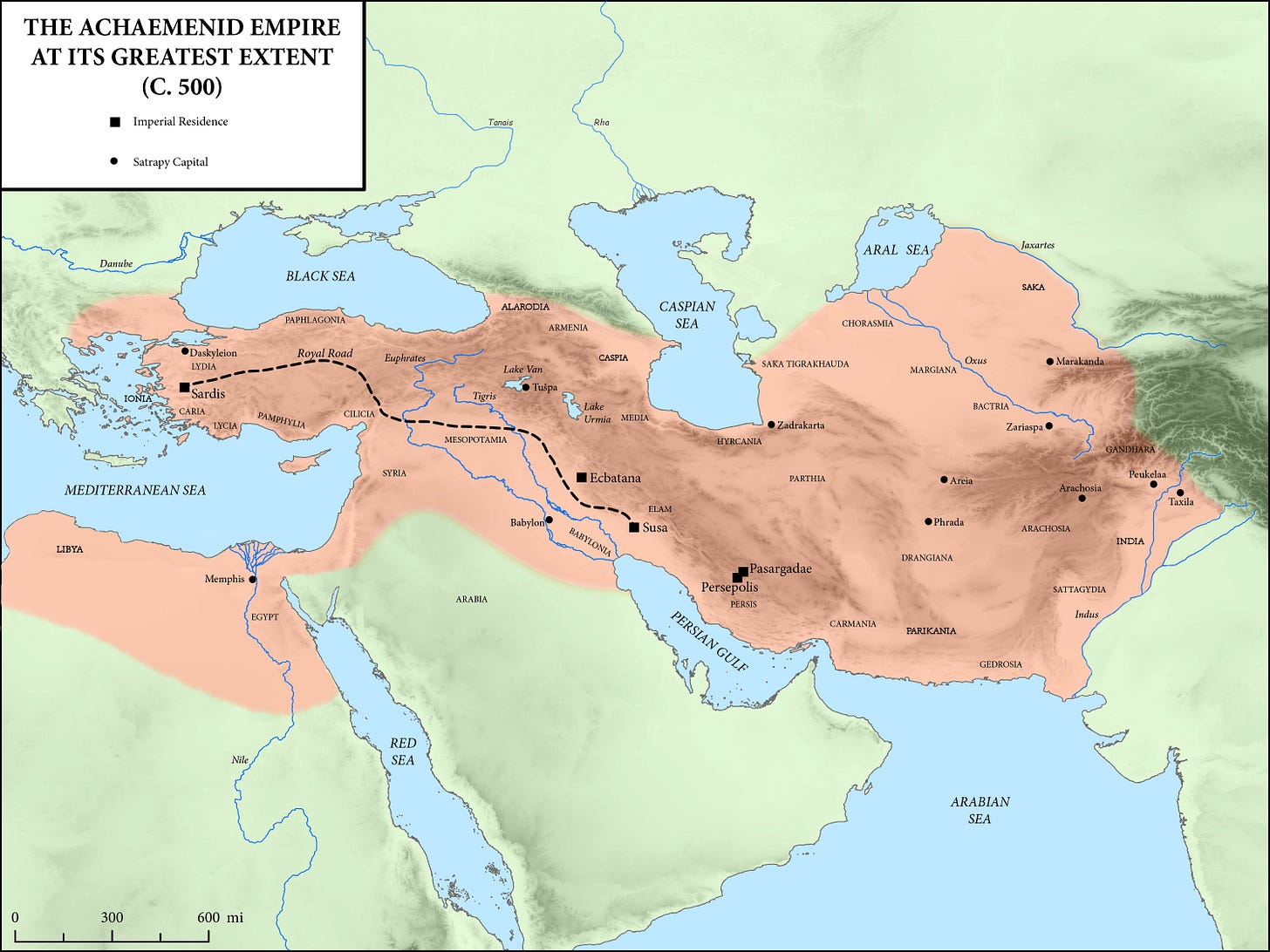The Achaemenid empire was the greatest ever seen at its time, spanning all the way from Egypt to the Indus Valley.
In this article, we’ll take a look at what the Achaemenid empire really was, how the Persian monetary system worked, and explore Bankers’ marks that can often be found on the coins. Enjoy!
My “handful” of Persian Sigloi1
What Was The Achamenid Empire?
The First Persian Empire was founded by Cyrus the Great in the mid 6th Century BC. Cyrus managed to beat Lydia, the Neo-Babylonian empire and the Median empire, an astonishing feat. The Achaemenids flourished for over 200 years, notable for their extremely diverse population, well administered bureaucracy and artistic achievements. They were finally defeated and taken over by Alexander the Great in 330 BC, and the empire was split up by his generals following his death.
The Achaemenid empire under its greatest extent2 covered 5,500,000 km23
The Persian Monetary System
The Persian monetary system was bimetallic. That is to say, it only consisted of coins made up of 2 metals: silver and gold. The base Persian silver coin was known as the Siglos, and the gold coin the Daric. A daric, the monthly wage for a soldier, would have been equivalent to 20 sigloi.
Sigloi (and darics) remained very similar in design over the long period that they were issued. On the obverse you’ll find the great king as an archer in a variety of poses often holding other weapons such as a spear or dagger. There are some other slight differences over time too, such as minor weight changes and a decline in purity over time from 98% to about 94%, yet I find it remarkable how constant these coins were over centuries of usage.
There are also some references to these coins in ancient texts (including being mentioned twice in the Hebrew bible). Here’s one example:
At the very start of the 4th Century BC, Achaemenids bribed the Greeks to fight Sparta. Plutarch reports that the Spartan king said that he had been driven out by 10,000 “archers” (τοξόται in ancient Greek), a nickname for gold Darics given their obverse depiction.
"I have been driven out by 10,000 Persian archers" - Agesilaus4
A Persian gold daric featuring the king shooting an arrow on the obverse5
Sigloi and Countermarks
Sigloi are also remarkable coins in that they so commonly exhibit countermarks and bankers’ marks. These are symbols stamped onto the coins by merchants, and were used for a variety of reasons, namely to validate currency or allow it to circulate in an area outside of where it was originally designed to circulate.6
Something I noticed about my lot of sigloi i that they all feature one common countermark; a Pi symbol: 𝛑. This is of interest because it suggests that this was the last bankers’ mark applied to the coins before they were hoarded. A wonderful ancient coin Youtuber also managed to use countermarks to learn more about a piece; he was able to track the journey that his Athenian owl made in antiquity!7 These are some wonderful examples of how countermarks can not only give us valuable information about coin types, but also individual coins!
In my opinion, the wonderful variety of these symbols and the fact that they give the coins even more historical value is highly alluring. Sigloi are also very readily available and inexpensive; they can be had for as little as £20. Therefore, I would definitely recommend them to any beginners interested in classical numismatics.
Sigloi feature many wonderful countermarks!8
What would you like to see next week? Have your say, with the poll below!
Here are the options (the poll will only last for 3 days):
The Most Famous Ancient Coin - An Introduction to the Athenian Tetradrachm
Collecting on a Budget - Ancient coins from £1 to £50
Thanks very much for reading, and χαῖρε!
Photo courtesy of https://www.romanumismatics.com/
Original creator: MossmapsCorrections according to Oxford Atlas of World History 2002, The Times Atlas of World History (1989), Philip's Atlas of World History (1999) by पाटलिपुत्र, CC BY-SA 4.0 <https://creativecommons.org/licenses/by-sa/4.0>, via Wikimedia Commons
Classical Numismatic Group, Inc. http://www.cngcoins.com, CC BY-SA 3.0 <http://creativecommons.org/licenses/by-sa/3.0/>, via Wikimedia Commons
See Classical Numismatic’s video titled “Ancient Coins: The Tetradrachm Ep. 1 - From Athenian Owls to Macedonian Lions”
See https://www.forumancientcoins.com/numiswiki/view.asp?key=siglos for a list of countermarks and discussion of types






I love the Persian Empire. I love how Cyrus, Cambyses and Darius set the tone while Xerxes and Artaxerxes added to it and I love how there is finally something about it on the internet
Ludovicus- I’m entirely new in numismatic so this is an interesting read. Of all the great insights here, for some reason I could never wrap my head around how coins that existed today were also in the hands of those living many years ago! A great thought journey.